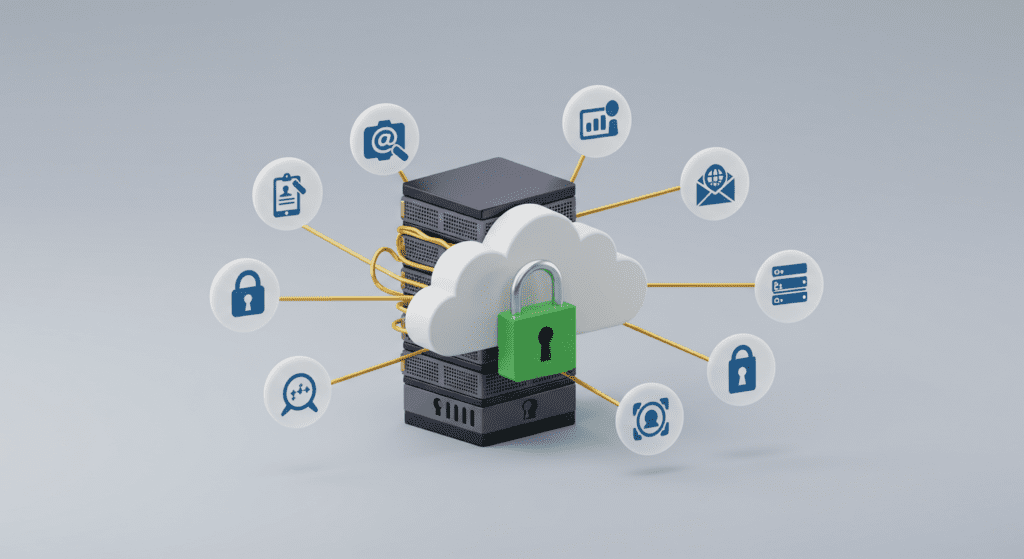cybersecurity for SaaS startups isn’t some optional plugin—it’s the backbone of your operation. The cloud is where dreams scale fast, but it’s also a neon sign for hackers drooling over your data. The rise in SaaS security risks targeting cloud-based startup security isn’t slowing down—think ransomware locking your servers, leaks spilling customer info, or phishing scams that hit like a sucker punch. One slip, and poof—trust’s gone, revenue’s tanking, and compliance fines are piling up quicker than you can reboot.
I’ve watched a scrappy SaaS team lose six months of hustle because they shrugged off SaaS data protection—their clients bailed, and the cleanup was a nightmare. The point is how the dark web impacts startups isn’t theoretical—it’s personal. This guide is your no-BS roadmap to securing a SaaS startup from cyber threats, packed with real-world fixes and a solid SaaS security framework for startups. Let’s lock it down—your business depends on it.
Understanding Cybersecurity for SaaS Startups
Running a SaaS gig isn’t like securing a corner store—securing SaaS applications comes with its quirks. Here’s the lowdown:
- What’s Different: Unlike traditional setups with on-prem servers, SaaS lives in the cloud, juggling multiple clients on shared systems—aka multi-tenant SaaS security. One tenant’s weak link can bleed into everyone else’s data. Scalability Is your edge, but it’s also a bullseye for SaaS security risks.
- Significant Challenges: You’re juggling user logins, third-party integrations, and APIs galore—every connection is a potential crack. Misconfiguring one setting and preventing SaaS data breaches gets dicey. Add remote teams on shaky Wi-Fi, and you’re begging for trouble.
- Compliance Jungle: SaaS compliance and security aren’t optional. Regs like GDPR (Europe’s privacy hammer), SOC 2 (trust badge), HIPAA (healthcare lockbox), and ISO 27001 (global gold standard) aren’t just legalese; they’re your ticket to big clients. Miss one, and you’re sidelined.
A SaaS founder I know skipped SOC 2 prep—thought it was “too corporate.” Lost a $100K deal when the client asked for proof. Another buddy ignored GDPR—and faced a €50K fine after a tiny leak. Cloud security for startups isn’t fluff—it’s your shield against chaos.
Top SaaS Security Risks to Watch
Hackers have a soft spot for SaaS startups—fresh meat with enormous potential. Here’s how they pounce and how the dark web affects your game:
1. Data Breaches & Leaks
Weak passwords, sloppy configs, or a forgotten API key can leave your platform wide open. Preventing SaaS data breaches is a grind—Verizon’s 2024 report pegs 81% of breaches to shaky authentication. Remember Slack’s 2015 mess? User data leaked like a sieve—classic SaaS wake-up call. A small CRM startup I know forgot to lock an S3 bucket—customer emails hit the dark web in a week. That’s your SaaS data protection on the line.
2. Account Takeovers & Credential Stuffing
Hackers scoop passwords from dark web dumps—think millions of credits from old breaches—then slam your logins with bots. It’s called credential stuffing, and it’s brutal. According to Microsoft’s stats, securing SaaS applications with Multi-Factor Authentication (MFA) stops 99% of these. I saw a SaaS team dodge a bullet—MFA caught a rogue login from halfway across the globe. No MFA? You’re rolling the dice.
3. Insider Threats & Employee Slip-Ups
Your crew can screw you—intentionally or not. A pissed-off dev might leak keys; a newbie might click a phishing link. SaaS security risks explode without Role-Based Access Controls (RBAC)—why let a marketer see the database? A SaaS I know had an ex-employee sell API creds after a bad breakup—it cost them a client and a massive cleanup bill. Negligence is just as bad—how to protect SaaS customer data from breaches starts with who’s got the keys.
4. API Vulnerabilities & Third-Party Risks
APIs are your SaaS lifeblood—connecting apps, syncing data—but they’re hacker candy. Protecting SaaS businesses from cyber threats means nailing API security—rate limiting (slows brute force), encryption (scrambles data), OAuth 2.0 (safe tokens). Third-party tools? One sketchy plugin can unravel you. A SaaS buddy got burned by a lax integration—hackers slipped in through an unpatched API. Vet every connection like it’s a job interview.
5. Ransomware & DDoS Attacks
Ransomware Is a SaaS nightmare—gangs buy cheap malware kits online, lock your data, and demand crypto. How cybercriminals use the dark web for hacking fuels this—Huntress’ 2025 report ties 75% of ransomware to dark web deals. DDoS? They swamp your servers with junk traffic till you crash—cloud security for startups takes a beating. A SaaS pal paid $20K to unlock files after a ransomware hit; another lost a day to DDoS downtime—both sting.

SaaS Security Best Practices for Startups
Here’s your SaaS security framework for startups—a no-fluff best cybersecurity practices for SaaS companies playbook to keep the wolves out:
1. Lock Down Authentication & Access
- MFA: Phone code, app push—enforce it everywhere. Microsoft says it blocks 99.9% of account hacks—stats don’t lie.
- RBAC: Least privilege—sales don’t need server access. Period.
- Monitoring: Flag oddballs—logins at 3 AM from Nigeria when you’re in Texas? Red alert.
- Real Story: A startup I know caught a breach mid-flight—MFA pinged their phone and saved the day. Essential security measures for cloud-based startups start here.
2. Encrypt Like a Fort
- End-to-End: AES-256 for data at rest—military-grade, uncrackable.
- SSL/TLS: Secure transit—keeps prying eyes out. Test it—https:// is your friend.
- Hashing: Bcrypt or Argon2 for passwords—hackers hate it.
- Why It Works: A SaaS I know dodged a leak—encrypted backups meant stolen files were gibberish. How to protect SaaS customer data from breaches hinges on this.
3. Bulletproof Your APIs
- OAuth 2.0: Token logins—safe, scalable, standard.
- WAF: Web Application Firewalls—like Cloudflare—block SQL injections XSS nasties.
- Test: OWASP Top 10 scans—weekly, no excuses.
- Hack: A dev pal added rate limiting—cut brute-force attempts by 80%. Securing SaaS applications lives or dies by API grit.
4. Audit Like a Paranoid Boss
- Scans: Tools like Nessus or Qualys—sweep for holes monthly.
- Pen Testing: Ethical hackers—pay ’em to break in and fix what they find. I’ve seen startups uncover gaping flaws this way.
- Compliance: SOC 2, GDPR, HIPAA—nail audits, win trust. SaaS security compliance regulations aren’t optional.
- Payoff: A SaaS team I know passed SOC 2—and landed a $200K contract the next month.
5. Train Your People—Seriously
- Phishing Drills: Send fake emails—see who bites, teach ’em why it’s terrible.
- Remote Rules: VPNs, no Starbucks Wi-Fi—lock it tight.
- Passwords: 12+ chars, random, via LastPass or 1Password—no “Summer2025.”
- Real Talk: A SaaS company I know cut phishing clicks 50% with training. Best cybersecurity practices for SaaS companies need sharp humans.
The Role of SaaS Compliance and Security
Compliance isn’t just lawyer bait—it’s your SaaS superpower. Here’s the scoop:
The Big Four:
- GDPR: €20M fines if EU data leaks—encrypt or bust.
- CCPA: California’s privacy punch—customers can sue sloppy startups.
- SOC 2: Trust audits—clients demand it.
- HIPAA: Health data? Lock it, or lawyers swarm.
- Why: SaaS compliance and security aren’t just legal—they’re a sales pitch. “We’re SOC 2 certified” seal deals—SaaS security compliance regulations scream legit.
- How: Document everything—policies, logs, encryption. Hire an auditor—$5K beats losing a client.
A SaaS founder got GDPR-ready and nabbed a European deal worth six figures. Another ignored HIPAA and lost a healthcare client overnight. Compliance isn’t “nice”—it’s cloud security for startups.
Choosing the Right Tools for Cloud Security for Startups
Gear up—here’s your essential security measures for cloud-based startups toolkit:
Cloud Guardians:
AWS Security Hub: AWS users—real-time Vuln alerts, which are cheap to start.
Google Security Command Center: GCP folks—spot misconfiguration fast.
- Endpoint Locks:
- CrowdStrike: Malware killer—light, fierce.
SentinelOne: AI-driven—stops threats cold.
- API Shields:
- Wallarm: Blocks API attacks—SaaS must-have.
Salt Security: Deep API scans are worth the bucks.
- DDoS Defenders:
- Cloudflare: Free tier kills essential floods—scale later.
Akamai: Enterprise-grade—pricey but bulletproof.
- Dark Web Watch:
- SpyCloud: Finds leaked creds—cheap insurance.
Have I Been Pwned: Free email checks—start here.
Pro Move: Mix freebies (Cloudflare) with paid (CrowdStrike)—SaaS security best practices don’t need a fortune. A SaaS I know paired Cloudflare and SpyCloud—caught a leak before it blew up.

Conclusion
Cybersecurity for SaaS startups isn’t a side hustle—it’s your 2025 survival kit. SaaS security risks like breaches, ransomware, and API hacks don’t care if you’re pre-revenue or Series A—they’ll gut you all the same. But here’s the upside: protecting SaaS businesses from cyber threats isn’t rocket science. Build a SaaS security framework for startups with MFA, encryption, audits, and training—best cybersecurity practices for SaaS companies that work.
Stay ahead with SaaS compliance and security; your clients will stick around. Don’t wait for a ransom note—start now, sleep later. Got a SaaS security win? Spill it below—I’m all ears!
FAQs:
1. Why’s cybersecurity for SaaS startups a big deal?
SaaS lives in the cloud—hackers feast there. One breach tanks trust and cash—SaaS security risks don’t mess around.
2. What’s the best cybersecurity practices for SaaS companies?
MFA, encryption, API locks, audits—how to secure a SaaS startup from cyber threats starts simple and scales smart.
3. How to protect SaaS customer data from breaches?
Encrypt it (AES-256), enforce MFA, limit access—SaaS data protection basics that bite back.
4. What’s tricky about cloud security for startups?
Multi-tenant SaaS security—one flaw hits all tenants. APIs and remote crews add spice to cloud-based startup security.
5. How do SaaS security compliance regulations pay off?
GDPR, SOC 2—SaaS compliance and security proves you’re tight, land deals.
6. Top tools for securing SaaS applications?
CrowdStrike (endpoints), Cloudflare (DDoS), and Wallarm (APIs) are essential security measures for cloud-based startups.
7. Can startups afford a SaaS security framework for startups?
Freebies like Have I Been Pwned, cheap audits—preventing SaaS data breaches start to lean.
8. How often should I audit for SaaS security risks?
Monthly scans, yearly pen tests—cloud security for startups thrives on paranoia.

